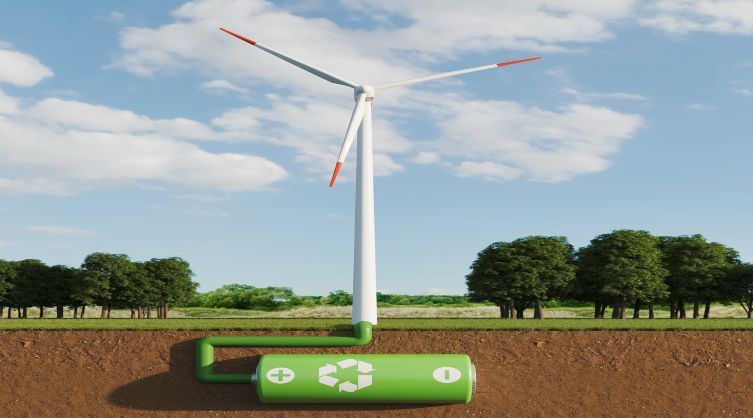Green hydrogen market projected to rise from $574.2 mn in 2023 to $24,925.2 mn by 2033
By EPR Magazine Editorial November 6, 2023 5:03 pm IST
By EPR Magazine Editorial November 6, 2023 5:03 pm IST

Forward momentum of the green hydrogen market is being propelled by technological advancements in electrolysers and storage solutions, with the alkaline electrolyser category attracting substantial investments, making it the largest segment within the market.
The green hydrogen market is on the cusp of a transformative journey with the potential to revolutionise the energy sector. Its eco-friendliness and diverse range of applications position green hydrogen as a promising alternative to fossil fuels. Recent market research conducted by ChemView Consulting suggests that the market value for green hydrogen is poised to surge, projected to rise from $574.2 million in 2023 to a substantial $24,925.2 million by 2033. Furthermore, the study asserts that the market is expanding at an extraordinary compound annual growth rate (CAGR) of 45.8 percent.
The forward momentum of the green hydrogen market is being propelled by technological advancements in electrolysers and storage solutions, with the alkaline electrolyser category attracting substantial investments, making it the largest segment within the market.
The demand for green hydrogen is on the rise, particularly in Europe, the largest market for green hydrogen products. The European Union’s ambitious target to achieve net-zero emissions by 2050 is a driving force behind this demand, and this momentum is beginning to extend to other regions.
However, despite these promising prospects, the green hydrogen industry faces significant challenges, primarily linked to the high costs associated with manufacturing and storage. Even with notable technological advancements, the sector requires more cost-effective solutions to gain broader traction.
Nonetheless, the green hydrogen market abounds with opportunities for growth and innovation. As governments and industries seek to reduce their carbon footprints, green hydrogen holds immense potential as a sustainable energy source, offering the possibility of a cleaner and more sustainable future.
The industry has enormous growth potential, particularly in transportation, energy storage, and industrial applications. Companies are looking into partnerships and collaborations to capitalise on these opportunities and increase their market reach.
“The green hydrogen industry is expanding at an exponential rate, driven by rising environmental concerns and the need for sustainable energy alternatives. Governments and organisations are investing extensively in research and development to make green hydrogen a viable alternative for a variety of uses” opines a senior research analyst at ChemView Consulting.
The green hydrogen market is witnessing a significant shift in the technological landscape, with two key electrolyser types taking the lead: Alkaline Electrolysers and Proton Exchange Membrane (PEM) Electrolysers. These technologies play a crucial role in the generation of green hydrogen, a sustainable energy source that holds great promise for the future.
Alkaline Electrolysers have long been a cornerstone of the green hydrogen industry, accounting for a substantial 66.18 percent of total sales in 2021. This prominence can be attributed to their traditional use in green hydrogen production initiatives. Alkaline electrolysers typically employ a liquid alkaline solution of potassium or sodium hydroxide as the electrolyte. They boast a longer operational lifespan compared to their PEM counterparts. However, they operate at lower power and current densities, and at higher temperatures, ranging from 100 to 105 degrees celsius, compared to PEM electrolysers, which operate within the 70-to-90-degree range. Despite these limitations, the category continues to grow, primarily due to its cost-effectiveness when compared to PEM electrolysers.
On the other hand, PEM Electrolysers are emerging as strong contenders in the green hydrogen market, showing robust growth prospects. These systems utilise solid specialised plastic-based electrolytes, offering enhanced flexibility in terms of functionality. The growth of PEM electrolysers can be attributed to factors such as increased proton conductivity, reduced gas permeability, and thinner proton exchange membranes.The industry is actively focused on commercial-scale deployment of PEM electrolyser technology to enhance the overall power efficiency of green hydrogen production. For instance, in January 2020, the United Kingdom-based company ITM Power formed a joint venture with ITM Linde Electrolysis GmbH, with the aim of providing industrial-scale green hydrogen using a PEM electrolyser with a capacity exceeding 10 MW. This partnership underscores the industry’s commitment to advancing PEM technology, thereby contributing to the overall expansion of the green hydrogen market.
Regionally, the green hydrogen market is witnessing different levels of development:
Europe: Europe leads the industry, driven by proactive regulations and investments in sustainable energy solutions. Germany and France are at the forefront of green hydrogen projects and initiatives.
North America: The United States government’s growing interest in green hydrogen, as part of its clean energy programme, is expected to drive research and development investments and market expansion in the region.
Asia-Pacific: Except for Japan, the Asia-Pacific region is still developing its green hydrogen market. Countries like China and India are investing in projects to reduce carbon emissions and establish long-term energy alternatives.
Japan: Japan has a particular interest in green hydrogen due to its potential in energy storage and mobility. The government has set ambitious goals to transform the country into a hydrogen-based economy by 2050.
Latin America and Middle East and Africa: These regions are emerging markets with substantial promise. Investments in renewable energy are expected to fuel market growth.
Key players in the green hydrogen market, including Siemens, Nel Hydrogen, and Hydrogenics, are actively investing in new technologies and forming strategic partnerships to expand their market reach. For instance, Siemens has recently collaborated with other energy companies to develop new green hydrogen production facilities, Nel Hydrogen is focused on efficient electrolyser development, and Hydrogenics has been acquired by Cummins Inc. with the aim of expanding its green hydrogen production capabilities. These key players play a vital role in driving innovation and growth in the industry.
These insights are based on recent findings on Green Hydrogen Market by Chemview Consulting
We use cookies to personalize your experience. By continuing to visit this website you agree to our Terms & Conditions, Privacy Policy and Cookie Policy.